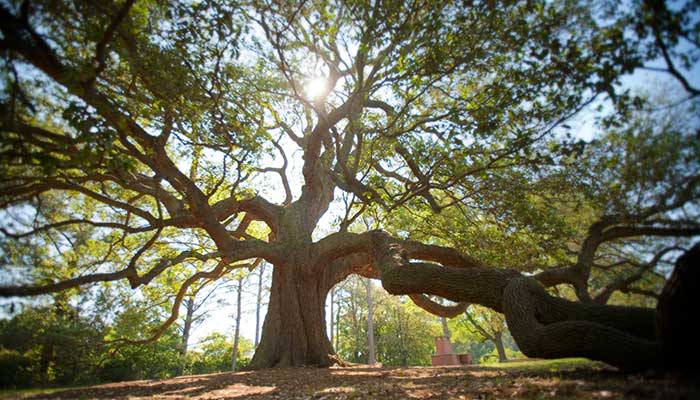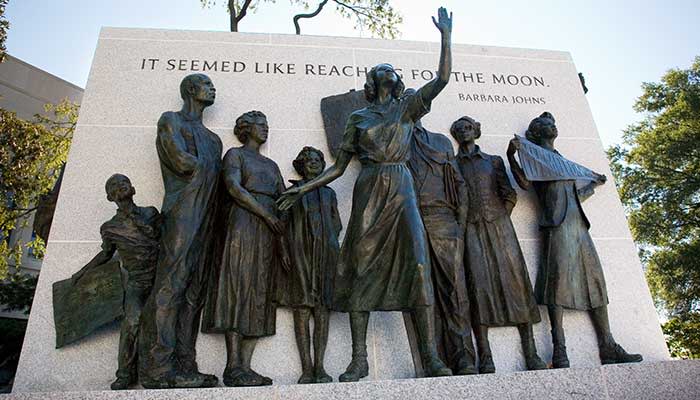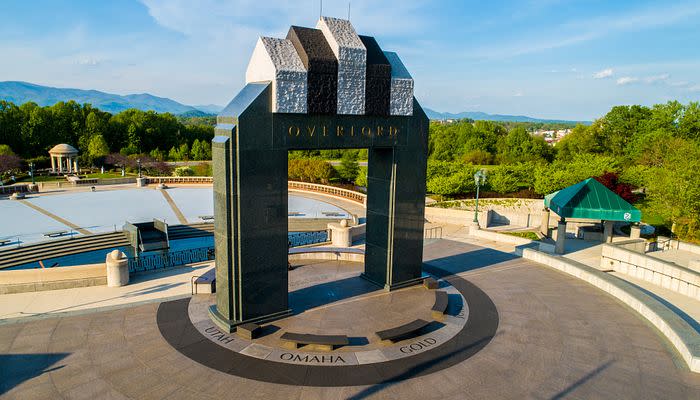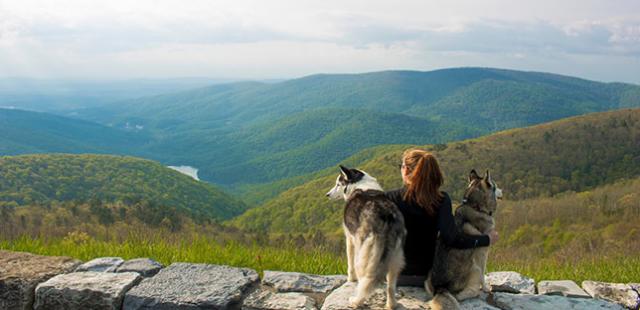Black History Attractions
Virginia is home to the longest continuous experience of Black life and culture in the United States spanning more than four centuries – beginning before the first English settlement at Jamestown and through the Revolutionary War, Civil War, Emancipation and the Civil Rights eras.
Learn more about Black history across Virginia at the museums and sites listed below offering permanent exhibits and tours.
Black History Trail
COASTAL VIRGINIA
Hampton & Newport News
In August 1619, the first recorded Africans arrived at Point Comfort, site of Fort Monroe in Hampton, after being forced from their villages in present-day Angola and pushed onto a Portuguese slave ship headed for the New World. Read More
Fort Monroe was dubbed “Freedom’s Fortress” for protecting runaway slaves during the Civil War and is recognized as a national monument for the origin and endpoint of slavery. Learn more about the arc of freedom at the Casemate Museum and new Fort Monroe Visitor and Education Center.

Visit Emancipation Oak, where President Lincoln's Emancipation Proclamation was first read to Hampton's people, at Hampton University, founded in 1868 as an institute of higher learned for newly freed blacks. The university museum is the oldest and largest African American museum in the nation and features artifacts and contemporary art from countries and cultures worldwide.
In the sanctuary of Hampton's Little England Chapel, the only known African-American missionary chapel in the state, see a short video and collection of photographs and materials that help explain the religious lives of post-Civil War Black people.
To learn about the first Black U.S. aviators, visit the Virginia Air & Space Center and see the photographic exhibit of Tuskegee Airmen.
In Newport News, tour The Newsome House Museum, which commemorates J. Thomas Newsome, one of the first African-American lawyers to argue before the Virginia Supreme Court. Learn about the heroics of African-American soldiers at the Virginia War Museum, and talk with a bucket maker about life as a freed Black in colonial times at the Mariners' Museum.
Williamsburg
At Jamestown in 1625, a woman named “Angelo” (Angela), was one of the first Africans listed in a colony-wide census as living in the household of Captain William Pierce of New Towne. Visit the Angela Site at Historic Jamestowne where archeologists are excavating the site of Pierce’s property to learn more about Angela’s world.

During the Revolutionary era, most African Americans lived in the Chesapeake region, about 50-60 percent of the overall population. Visit Colonial Williamsburg and learn about the people who worked on tobacco plantations and large farms at the Slave Quarter at Carter's Grove.
Visit Jamestown Settlement and American Revolution Museum at Yorktown to learn about an African family who lived at Jamestown. An estimated 100,000 African Americans escaped, died or were killed during the American Revolution.
Norfolk, Portsmouth, Chesapeake, and Suffolk
In nearby Norfolk, visit West Point Cemetery to view the Black Soldiers Memorial, honoring Union veterans of the Civil War. At nearby Norfolk State University, the largest predominately Black university in the nation, find an exhibit on enslaved persons at the Lyman Beecher Brooks Library.
In Portsmouth, take a walking tour past the Emanuel A.M.E. Church, furnished with benches hand cared by slaves. Stop by the Portsmouth Colored Community Library Museum. Here you can find memorabilia, photographs, books and journals of Portsmouth's Black heritage.
See the Medal of Honor Monument that honors 11 soldiers, including Sgt. Charles Veal with the 4th U.S. Colored Troops who served at the Battle of New Market Heights in 1864.
While in Chesapeake, stop by the only visitor center in Virginia with an Afro-Union and Afro-Virginian repository theme, the J. J. Moore Visitor, Archives & Family Life Center.

In Suffolk, the Great Dismal Swamp was a waystation on the Underground Railroad, and a pavilion dedicated to it stands 3/4 of a mile down Railroad Ditch Road. Recent archaeological excavations now show that self-emancipated slaves created communities here as early as 1680. Dodging snakes and slave catchers, these people lived on high ground.
CENTRAL VIRGINIA
Richmond
Richmond, trace the slave trade from Africa to Virginia and onward throughout the United States until 1860, take a walk along the Richmond Slave Trail.
American Civil War Museum at Historic Tredegar is the gateway to Civil War travel in the region. A National Historic Landmark and one-time heart of Confederate war production, the site offers an interactive exploration of the Civil War on both the local and national levels through the perspectives of Union, Confederate, and African American participants.
For special exhibits on African-American life during the Civil War, visit the ACWM - Museum of the Confederacy.

Discover one of the country's foremost African-American communities, Jackson Ward, known as "The Harlem of the South" and Birthplace of Black Entrepreneurship. While there, visit the Home of Maggie Walker, the first female bank president in America and see a newly unveiled bronze statue of Walker. Also, visit the Black History Museum and Cultural Center which celebrates the rich culture and moving histories of Black people in Virginia.
The nearby Bill "Bojangles" Robinson statue recognizes the dancer best known for his tap dancing with child-star Shirley Temple.
A popular addition to Monument Avenue, considered to be one of the most beautiful boulevards in the world, is the statue of tennis star Arthur Ashe. A few blocks away, view African art at the Virginia Museum of Fine Arts.
The L. Douglas Wilder Library and Learning Center at Virginia Union University documents the life and career of Virginia's 66th governor and the first elected Black governor in U.S. history.. Wilder was the first elected African-American governor and currently serves as Richmond's mayor.
The Jackson Blacksmith Shop was built in 1880 by Henry Jackson, a freed slave. It was passed down through the generations until the 1970s. It is now listed on the Virginia Register of Historic Places.
Petersburg
The Joseph Jenkins Roberts Memorial commemorates independent Liberia's first president. Travel through The Triangle, Petersburg's African-American business center for more than a century until the 1970s. After Reconstruction, African Americans formed their own separate society with banks, drugstores, barbershops and even the Rialto Theater.
Gillfield Baptist Church, with what is believed to be the oldest handwritten Black church record book in America, opens its archives to interested visitors.
Petersburg National Battlefield is where a number of Civil War battles occurred between June 15, 1864 and April 1, 1865. About 40,000 slaves were promised their freedom if they agreed to fight for the South. Also, 187,000 African-Americans served in the Union army. Of those, the greatest concentration of U.S. Colored Troops (USCT) was at Petersburg.
Pamplin Historical Park & The National Museum of the Civil War Soldier sits on the property where the last battles of the Civil War occurred. See plantation life reenacted at Tudor Hall and the Military Encampment with full-scale earthworks dug by the slaves and military demonstrations. Plan to spend the day, because there's so much to see and do.
Pocahontas Island was one of the earliest predominantly African-American neighborhoods. The first enslaved people were brought here in 1732 to work in the tobacco warehouses. In 1797, free Blacks lived there, too. The National Park Service: "Petersburg was considered to have the largest number of free Blacks of any Southern city at that time. Many of the freedmen prospered there as barbers, blacksmiths, boatmen, draymen, livery stable keepers and caterers."
Farmville and Lynchburg
Farmville is the home of the Robert Russa Moton Museum, where a student strike in 1951 spurred the lawsuit of Brown v. The Board of Educationcase in 1954, a hallmark in the civil rights movement. Before you head that way, see the Virginia Civil Rights Memorial on Capitol Square in Richmond. It was erected in 2008 to honor the actions of 16 year-old Barbara Rose Johns of Robert Russa Moton High School.

Thomas Jefferson's Poplar Forest is his octagonal retreat near the Blue Ridge Mountains. Archaeologists have excavated four slave cabins at Poplar Forest, including both single family log cabins and a duplex for extended families. Learn about those who labored for Jefferson’s happiness through a guided enslaved community tour. Dig deeper through an Archaeology Behind-the-Scenes Tour or Barrels, Bottles and Casks Tour.
About an hour's drive to Lynchburg, tour the House and Gardens of Anne Spencer, the noted Harlem Renaissance poet and civil rights activist. Don't miss the special exhibits highlighting African-American involvement in the city's history at the Legacy Museum of African American History or the opportunity to take a Black History Walking Tour of the Old City Cemetery.
Charlottesville Area
To the north in Charlottesville, take a tour of the University of Virginia, founded by Thomas Jefferson and home to the Carter Woodson Institute, named for the "Father of Black History."
Thomas Jefferson's Monticello, lets you glimpse into Jefferson’s life and many accomplishments, as well as the paradox he lived by illustrating “all men are created equal” while enslaving more than 600 people over the course of his life. Mulberry Row, once the industrial “main street” of the 5,000-acre agricultural enterprise, has been restored to represent the lives of the enslaved. See Monticello through the lens of the Hemings Family, the best documented enslaved family in the United States, through special guided tours and the new exhibit, The Life of Sally Hemings, Jefferson’s concubine who not only bore several of his children but successfully negotiated their freedom as well.
Nearby, at James Monroe's home, Highland, tour the restored slave quarters, and discover Monroe's views on slavery and his involvement in the establishment of Liberia 1817.

James Madison's home in Orange, Montpelier, is the site for archeological digs, primarily around the original home of Mount Pleasant, which was built by slaves in 1723. The Mere Distinction of Colour exhibition, located in the cellars and south yard, examines the paradox of America's founding era, exploring slavery to connect the past to the present through the lens of the Constitution.
NORTHERN VIRGINIA
Fredericksburg and Mount Vernon
In Fredericksburg, take one of two self-guided walking tours that leads past a slave auction block, or visit a Black history exhibit at the Fredericksburg Area Museum.
At George Washington's Mount Vernon Estate & Gardens, tour the Greenhouse slave quarters and the slave burial ground. Through household furnishings, art works, archaeological discoveries, documents, and interactive displays, Lives Bound Together demonstrates how closely intertwined the lives of the Washingtons were with those of the enslaved.
Alexandria and Arlington
Farther north in Alexandria, visit the Freedom House Museum, Alexandria Black History Museum and African-American Heritage Park featuring a sculpture group of bronze trees, Truths that Rise from the Roots Remembered by sculptor Jerome Meadows and acknowledges the African Americans who contributed to the growth of Alexandria.
Virtual Tour of the Freedom House Museum in Alexandria:
At the Museum at Gum Springs Historical Society in Fairfax County, see the community started by West Ford, a former slave of George Washington, which is the oldest African-American community in Fairfax County, established in 1833. Located near Mount Vernon, it was a sanctuary for freed slaves and runaways.
Journey along the Black History Tour of Alexandria. Stops include the Franklin & Armfield Slave office and the Stabler-Leadbetter Apothecary.
The Manassas Industrial School/Jeannie Dean Memorial has an information kiosk and a bronze model outlying the foundations of this historic site. Also, look for the African-American exhibits at the Manassas Museum.
Nearby, the Afro-American Historical Association of Fauquier County is an African-American Museum and Genealogical Resource Center.
SOUTHWEST AND VIRGINIA MOUNTAINS
Africans first came to Virginia in the early 1500s — almost a century before the English permanently settled Jamestown in 1607 — as explorers and as members of Spanish and French Jesuit missions. By 1600, the first Melungeons were documented in the southern Appalachian valleys. The Melungeons were the first people, aside from Native Americans, to move into Virginia's Appalachian region. Many of the Melungeons were of Portuguese ancestry, with North African and Native American traits.
The Appalachian African-American Cultural Center features historical artifacts from the African-American experience in the Heart of Appalachia region.
Booker T. Washington was born on a tobacco plantation as a slave child. Learn about his early life, emancipation and his many accomplishments at the Booker T. Washington National Monument, which is overseen by the National Park Service.

Historic Christiansburg includes the Christiansburg Industrial Institute, a private primary school for African-Americans established in 1866 that was once supervised by Booker T. Washington. Visits to the Cambria Historic District, the Montgomery Museum and the Lewis Miller Regional Art Center are musts!
The Pulaski County Courthouse features the local history of Black people, developed by Lucy Harmon, wife of Chauncy, an early civil rights advocate in the 1950s.
When you stop in Bristol, be sure to tour the Nyumba Ya Tausi-Peacock Museum, home to African artifacts and local Black memorabilia, slave items and more.
Located just outside of Covington, the Longdale Recreation Area was completed in 1940 and dedicated as the "Green Pastures Recreation Area," an NAACP-requested site for African-American use at that time. The dam, bath house, picnic shelter and two restroom facilities are original to the site.
In Roanoke, the Harrison Museum of African American Culture is on the first floor of the first public high school for African-American students in Southwest Virginia. The museum aims to preserve and interpret the achievements of Black people in Southwestern Virginia with archives and collections of memorabilia, photographs, oral stories, and African and contemporary art.
In Bedford, the Bedford Historic Meeting House still has its original side door, stair and gallery, once used by slaves for the religious and educational purposes in the decades following the Civil War.

Also, in Bedford, see the National D-Day Memorial, dedicated on June 6, 2001. Bedford was selected as the memorial site because the city lost more citizen-soldiers per capita on D-Day than any other city in the nation.
SOUTHERN VIRGINIA
Near the Virginia-North Carolina border in Clarksville, see one of the oldest remaining slave quarters in Virginia at Prestwould Plantation, where a large collection of slave writings and records remain.
To the north in Prince Edward County, visit Twin Lakes State Park, once the only Virginia state park for Black people. Today, the park offers six miles of hiking and biking trails, picnic areas, campsites, a swimming beach and fresh-water fishing.
Representing more than 100 years on Martinsville's Fayette Street, the Fayette Area Historical Initiative African American Museum was created to collect, preserve and interpret the local Black experience. FAHI also displays images representative of Black history on the national level.
Black History Experiences
A Civil Rights Road Trip Through the Heart of Virginia
Day One: Appomattox & Lynchburg In Appomattox, Virginia, visit the Carver Price Legacy Museum. The museum documents the…
A Three-Day Tour Through Virginia's Student Civil Rights History
Day One: Farmville Farmville is known as the “Birthplace of the Student Civil Rights Movement.” Arrive and head to…
Explore These 6 Notable Civil Rights Sites in Virginia
Civil Rights history in Virginia has a complicated legacy. As the home of the capital of the Confederacy, it’s arguable…
Tracing the U.S. Civil Rights Trail Through Virginia
The journey to equality in the American education system spanned over a hundred years, involving many heroic individuals willing…
But Did You Know: Jackson Ward & Richmond's Pre-Eminent Black History
As the birthplace or adopted home of many African American artists, activists, and achievers whose contributions have shaped and…
18 Museums & Historic Sites to Learn About Virginia’s Black History
With the earliest Africans coming to shore in Virginia in 1619, the Commonwealth’s history is filled with important…
Come Home to Virginia - Black History Sites Part I
Virginia history is more than we have been taught. Many know Virginia as the mother of Presidents. It is also the place where at…
Come Home to Virginia: Black History Sites Part II
Welcome back to my blog post series, Come Home to Virginia – Black History Sites. I am a native and a resident of Virginia…















